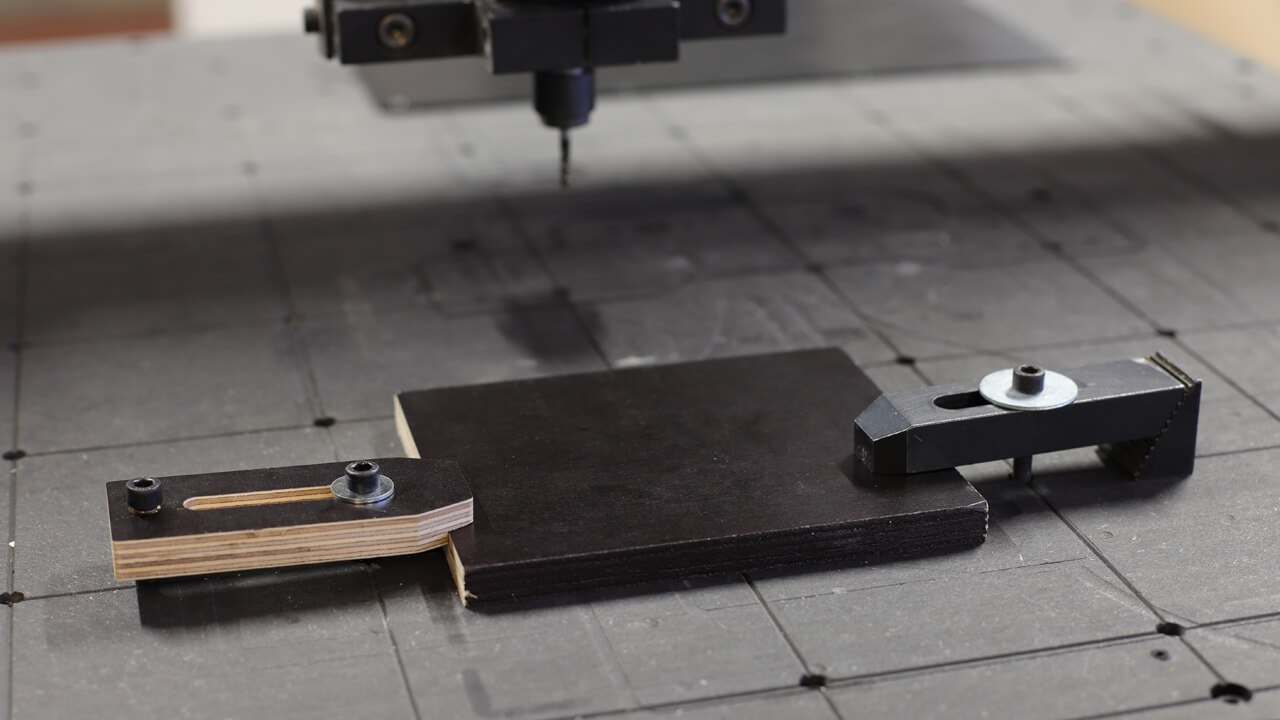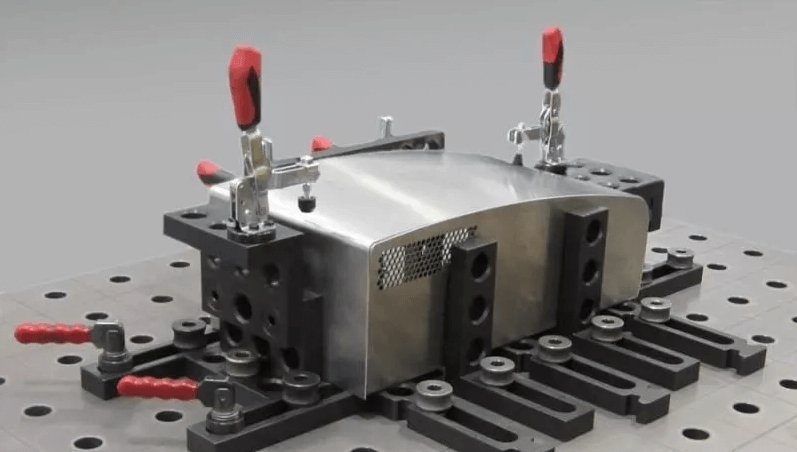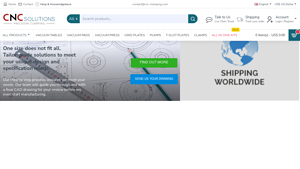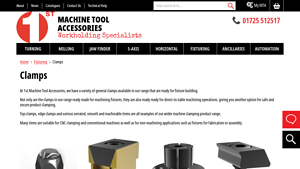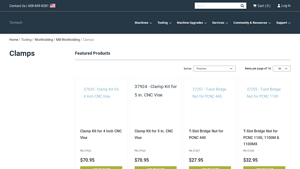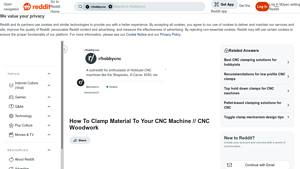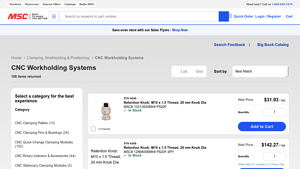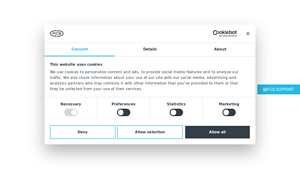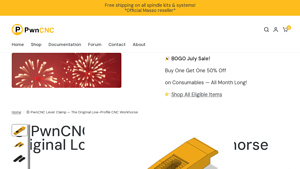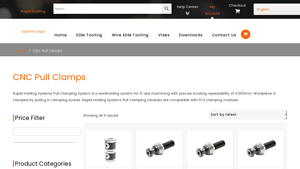Cnc Clamping Solutions Guide: Type, Cost, Top List…
Introduction: Navigating the Global Market for cnc clamping solutions
In the fast-paced world of CNC machining, sourcing reliable CNC clamping solutions can be a daunting task for international B2B buyers. The right clamping system is crucial not only for ensuring precision and quality in machining processes but also for maximizing operational efficiency and minimizing downtime. This comprehensive guide delves into the myriad types of CNC clamping solutions available, including toggle clamps, vacuum tables, and custom fixtures, to help you navigate the complexities of selecting the best options for your specific needs.
Our guide goes beyond mere product descriptions; it offers insights into applications, compatibility with various materials, and the nuances of each clamping system’s performance. Additionally, we provide expert advice on vetting suppliers, understanding cost implications, and assessing the adaptability of clamping solutions across different machining environments. With a keen focus on the needs of buyers from Africa, South America, the Middle East, and Europe—including emerging markets like Vietnam and Saudi Arabia—this resource empowers you to make informed purchasing decisions that align with your business objectives.
By leveraging the information in this guide, you can confidently choose CNC clamping solutions that enhance your production capabilities, reduce waste, and ultimately drive profitability in your operations.
Understanding cnc clamping solutions Types and Variations
| Type Name | Key Distinguishing Features | Primary B2B Applications | Brief Pros & Cons for Buyers |
|---|---|---|---|
| Wood Screws | Basic, strong, and adjustable fixing points | Woodworking, prototyping | Pros: Cost-effective, easy setup. Cons: Damages surfaces, limits surfacing. |
| Vacuum Clamps | Utilizes suction for secure, even holding | Metal and plastic machining, woodworking | Pros: Excellent for complex shapes, minimal setup time. Cons: Requires vacuum source, may not suit all materials. |
| Toggle Clamps | Quick clamping mechanism, adjustable for thicknesses | Production runs, assembly lines | Pros: Fast operation, reusable. Cons: Limited adaptability, not suitable for surfacing. |
| Step Blocks | Strong, ergonomic design with multiple sizes | Versatile machining applications | Pros: Easy to use, customizable. Cons: Requires T-slot compatibility. |
| Double-sided Tape | Adhesive-based, simple application | Light materials, intricate designs | Pros: Low-cost, allows full surfacing. Cons: Less secure, potential safety risks. |
What Are the Characteristics of Wood Screws as a Clamping Solution?
Wood screws are one of the most fundamental clamping solutions, particularly favored for their affordability and ease of setup. They provide a strong hold, making them ideal for initial projects or prototyping in woodworking. However, while they allow for adjustable fixing points, they can damage the surface of the spoiler board over time and limit the ability to perform full surfacing operations. Buyers should consider their project frequency and material type when opting for this method.
How Do Vacuum Clamps Enhance CNC Machining Processes?
Vacuum clamps leverage suction to secure workpieces, making them an efficient choice for machining complex shapes and delicate materials. Their ability to distribute pressure evenly across the surface minimizes distortion and enhances precision, making them suitable for high-accuracy applications in metal and plastic machining. However, they require a compatible vacuum source and may not be suitable for all materials, so businesses should assess their specific operational needs before investing.
Why Choose Toggle Clamps for Production Runs?
Toggle clamps are designed for rapid clamping and releasing, making them ideal for assembly lines and production runs where time efficiency is critical. They can accommodate varying workpiece thicknesses, but their effectiveness diminishes when frequent adjustments are needed. Additionally, toggle clamps do not allow for surfacing operations, which may limit their utility in more complex machining tasks. Companies should weigh their production volume against the need for versatility when considering toggle clamps.
What Advantages Do Step Blocks Offer in CNC Machining?
Step blocks are a popular choice due to their robust design and ergonomic usability. They come in various sizes and can be customized, making them adaptable for different machining applications. However, they require a T-slot working area or a threaded insert grid for effective use. Businesses should evaluate their workspace compatibility and the variety of projects they undertake to determine if step blocks are a fitting solution for their CNC needs.
When Should Double-sided Tape Be Considered for Clamping?
Double-sided tape is an innovative clamping method that offers a low-cost and straightforward application for lightweight materials. It allows for the machining of the entire surface without leaving tabs, which can enhance the quality of the finished product. However, its security is less reliable compared to mechanical clamps, and it poses safety risks if not used correctly. B2B buyers should consider the material characteristics and the nature of their projects when opting for this solution.
Key Industrial Applications of cnc clamping solutions
| Industry/Sector | Specific Application of CNC Clamping Solutions | Value/Benefit for the Business | Key Sourcing Considerations for this Application |
|---|---|---|---|
| Aerospace | Precision component machining for aircraft parts | Enhanced accuracy and reduced waste | Certifications, material compatibility, and delivery times |
| Automotive | Fixture design for mass production of vehicle components | Increased production efficiency and consistency | Customization options, durability, and ease of setup |
| Furniture Manufacturing | Clamping solutions for intricate wood cutting and assembly | Improved finish quality and reduced manual labor | Material compatibility, ergonomic design, and safety features |
| Electronics | PCB and component assembly using vacuum clamping | Higher precision and reduced risk of damage | Size adaptability, ease of integration, and reliability |
| Metal Fabrication | Clamping for welding and machining of metal structures | Stability during operations and improved safety | Load capacity, material durability, and versatility |
How Are CNC Clamping Solutions Utilized in the Aerospace Industry?
In the aerospace sector, CNC clamping solutions are crucial for the precision machining of aircraft components, such as turbine blades and fuselage parts. These clamping systems ensure that workpieces remain stable during high-speed cutting operations, minimizing vibrations that can lead to inaccuracies. International buyers should prioritize sourcing clamps that meet stringent aerospace standards and offer customization options to accommodate various component sizes and shapes.
What Role Do CNC Clamping Solutions Play in Automotive Manufacturing?
CNC clamping solutions are integral to automotive manufacturing, particularly in the design and production of fixtures for mass production lines. These systems facilitate quick setup changes, allowing manufacturers to maintain high throughput while ensuring that parts are consistently produced to exact specifications. Buyers must consider the durability of clamping solutions, as they need to withstand the rigors of high-volume production and offer compatibility with diverse materials used in vehicle construction.
How Are CNC Clamping Solutions Applied in Furniture Manufacturing?
In furniture manufacturing, CNC clamping solutions are employed for precise cutting and assembly of wooden components. These systems enhance the quality of finishes and reduce the manual labor required for clamping, allowing for more intricate designs. Buyers from regions with diverse wood types should focus on clamps that accommodate various thicknesses and shapes, ensuring versatility and efficiency in production processes.
Why Are CNC Clamping Solutions Important in Electronics Assembly?
CNC clamping solutions, particularly vacuum clamps, are widely used in the electronics industry for assembling printed circuit boards (PCBs) and other delicate components. The precise hold provided by these systems minimizes the risk of damage during the assembly process, ensuring high-quality outputs. Buyers should look for solutions that are adaptable in size and ensure a secure hold without causing any harm to sensitive components.
How Do CNC Clamping Solutions Benefit Metal Fabrication?
In metal fabrication, CNC clamping solutions are essential for providing stability during welding and machining operations. These clamps help secure heavy metal pieces, reducing movement that can lead to defects and enhancing safety for operators. When sourcing these solutions, businesses should consider factors such as load capacity, durability against wear and tear, and the ability to accommodate different metal types and thicknesses.
3 Common User Pain Points for ‘cnc clamping solutions’ & Their Solutions
Scenario 1: Inconsistent Clamping Pressure Leads to Quality Issues
The Problem: A common challenge faced by B2B buyers in the CNC machining sector is the inconsistency of clamping pressure during operations. This inconsistency can lead to variations in cut quality, resulting in rejected parts and increased waste. Buyers may find that standard clamping solutions do not provide adequate pressure control, especially when machining materials with different densities or geometries. Furthermore, fluctuations in clamping force can cause vibrations, adversely impacting tool life and surface finish.
The Solution: To address this issue, B2B buyers should consider investing in adjustable clamping systems that allow for precise control over clamping pressure. Solutions like pneumatic clamps or hydraulic clamping systems provide the ability to fine-tune pressure settings, ensuring that the workpiece is held securely without distortion. When sourcing these systems, buyers should look for suppliers who offer customizable options, allowing them to tailor the clamping solution to their specific material and operational requirements. Additionally, implementing a routine maintenance schedule to check and calibrate clamping equipment can help maintain consistent pressure and enhance machining quality.
Scenario 2: Limited Flexibility for Diverse Workpiece Sizes
The Problem: Many B2B buyers encounter challenges when dealing with a variety of workpiece sizes and shapes. Standard clamping solutions may not accommodate all dimensions, leading to inefficiencies and delays in production. This limitation forces manufacturers to either invest in multiple clamping systems or compromise on the quality and safety of their setups, resulting in potential damage to both the workpiece and the machine.
The Solution: To overcome this limitation, buyers should explore modular clamping systems that offer versatility and adaptability. These systems typically include components like step blocks, T-slot plates, and adjustable clamps that can be configured to suit various workpiece dimensions. When selecting these systems, it is crucial to consider the compatibility of the clamping solution with existing CNC machines. Buyers should also consult with suppliers about custom solutions that can be designed to fit specific workpiece requirements. Additionally, investing in a comprehensive training program for operators on how to efficiently use these versatile clamping systems can significantly enhance productivity and reduce setup time.
Scenario 3: Safety Concerns with Non-Secure Clamping Methods
The Problem: Safety is a paramount concern in CNC machining environments, yet many buyers resort to outdated or non-secure clamping methods due to budget constraints or lack of awareness. This can lead to dangerous situations where workpieces become dislodged during machining, posing risks to both personnel and equipment. Furthermore, inadequate clamping can result in compromised workpiece integrity, leading to costly rework and downtime.
The Solution: To mitigate safety risks, B2B buyers should prioritize investing in high-quality clamping solutions that are specifically designed for secure operation. This includes adopting advanced clamping technologies such as vacuum clamping systems or specialized toggle clamps that provide reliable holding force. Buyers should also conduct a thorough assessment of their machining processes to identify any areas where safety may be compromised due to inadequate clamping. Collaborating with suppliers who offer robust safety features, such as automatic shut-off systems or pressure sensors, can further enhance operational safety. Training staff on the importance of proper clamping techniques and regularly reviewing safety protocols will foster a safer working environment and contribute to overall operational efficiency.
Strategic Material Selection Guide for cnc clamping solutions
What Are the Key Materials for CNC Clamping Solutions?
When selecting materials for CNC clamping solutions, it is essential to consider their properties, advantages, and limitations. The choice of material can significantly impact the performance, durability, and overall cost-effectiveness of the clamping system. Here, we analyze four common materials used in CNC clamping solutions: aluminum, steel, plastic, and composite materials.
How Does Aluminum Perform in CNC Clamping Solutions?
Aluminum is a lightweight metal known for its excellent strength-to-weight ratio and corrosion resistance. It typically withstands temperatures up to 200°C and is suitable for various machining applications. The primary advantages of aluminum include its low weight, making it easy to handle and install, and its resistance to rust and corrosion, which is crucial for longevity.
However, aluminum has a lower tensile strength compared to steel, which may limit its use in heavy-duty applications. Additionally, while it is relatively affordable, aluminum can be more expensive than some plastics or composite materials. For international buyers, particularly in regions with high humidity like parts of Africa and the Middle East, aluminum’s corrosion resistance makes it a favorable choice, but compliance with standards such as ASTM and DIN should be verified.
What Are the Benefits of Steel in CNC Clamping Solutions?
Steel is widely regarded as one of the most robust materials available for CNC clamping solutions. It offers high tensile strength, making it suitable for heavy-duty applications and capable of withstanding high pressures and temperatures. Steel’s durability ensures that clamping systems can maintain their integrity over time, even under rigorous use.
On the downside, steel is heavier than aluminum, which can complicate handling and installation. It is also susceptible to corrosion unless treated or coated, which can increase costs. For B2B buyers in regions like Europe and South America, where high-quality steel standards are prevalent, compliance with ASTM or JIS standards is critical to ensure product reliability and safety.
How Do Plastics Compare in CNC Clamping Solutions?
Plastic materials, such as nylon and polycarbonate, are increasingly used in CNC clamping solutions due to their lightweight and non-corrosive properties. They can withstand moderate temperatures and are often used in applications that require electrical insulation or chemical resistance. Plastics are also typically less expensive than metals, making them an attractive option for cost-sensitive projects.
However, the main limitation of plastics is their lower strength compared to metals, which can restrict their use in high-load applications. Additionally, they may not perform well under extreme temperatures. For international buyers, particularly those in regions with diverse climates like Vietnam, the choice of plastic should consider temperature and chemical exposure to ensure compatibility with specific applications.
What Role Do Composite Materials Play in CNC Clamping Solutions?
Composite materials, such as fiberglass and carbon fiber, offer unique advantages in CNC clamping solutions. They provide high strength while being lightweight and resistant to corrosion. Composites can withstand a wide range of temperatures and are often used in specialized applications requiring high performance.
The primary drawback of composites is their higher manufacturing complexity and cost, which can be a barrier for some buyers. For B2B buyers in the Middle East and Africa, where budget constraints may be a concern, the investment in composite materials should be carefully evaluated against the performance benefits they provide. Compliance with international standards is also essential when sourcing composite materials to ensure quality.
Summary Table of Material Selection for CNC Clamping Solutions
| Material | Typical Use Case for CNC Clamping Solutions | Key Advantage | Key Disadvantage/Limitation | Relative Cost (Low/Med/High) |
|---|---|---|---|---|
| Aluminum | Lightweight clamps for precision machining | Excellent corrosion resistance | Lower tensile strength than steel | Medium |
| Steel | Heavy-duty clamping in industrial settings | High tensile strength | Susceptible to corrosion | Medium to High |
| Plastic | Electrical insulation and lightweight clamps | Lightweight and cost-effective | Lower strength under high loads | Low |
| Composite | Specialized high-performance applications | High strength-to-weight ratio | Higher manufacturing complexity and cost | High |
This strategic material selection guide aims to assist international B2B buyers in making informed decisions regarding CNC clamping solutions, ensuring compatibility with their specific needs and operational environments.
In-depth Look: Manufacturing Processes and Quality Assurance for cnc clamping solutions
What Are the Main Stages of Manufacturing CNC Clamping Solutions?
Manufacturing CNC clamping solutions involves several key stages, each crucial for ensuring the final product meets the rigorous demands of precision engineering. The main stages include material preparation, forming, assembly, and finishing.
How is Material Prepared for CNC Clamping Solutions?
Material preparation is the foundational step in the manufacturing process. Typically, high-grade materials such as aluminum, steel, or engineered plastics are selected based on the application requirements. The materials undergo processes like cutting to size, deburring, and surface treatment to remove any impurities or irregularities. This step is vital as it directly impacts the performance and durability of the clamping solutions.
What Forming Techniques Are Commonly Used in CNC Clamping Manufacturing?
The forming stage involves shaping the prepared materials into functional components. Common techniques include CNC machining, stamping, and bending. CNC machining is particularly prevalent due to its ability to create precise and complex geometries that are essential for effective clamping. Other methods, such as laser cutting and waterjet cutting, may also be employed for creating intricate designs or patterns on the clamping surfaces.
How is Assembly Conducted in the Manufacturing of CNC Clamping Solutions?
Assembly is a critical phase where individual components are brought together to form a complete clamping solution. This process often involves the use of jigs and fixtures to ensure alignment and accuracy. Depending on the complexity of the design, assembly may be manual or automated. For example, automated assembly lines may be used for high-volume production, while custom or low-volume orders might require more manual intervention. Each assembly operation is executed under strict guidelines to maintain quality and consistency.
What Finishing Processes Are Involved in CNC Clamping Solutions?
Finishing processes are the final touchpoints that enhance the performance and aesthetics of CNC clamping solutions. Techniques such as anodizing, powder coating, or plating are commonly used to improve corrosion resistance and surface finish. These processes also contribute to the longevity of the clamping systems, making them suitable for various operating environments, including those with high humidity or exposure to chemicals.
What International Standards Govern Quality Assurance in CNC Clamping Manufacturing?
Quality assurance is paramount in manufacturing CNC clamping solutions, and adherence to international standards ensures that products meet global quality benchmarks. ISO 9001 is one of the most recognized quality management standards, focusing on continuous improvement and customer satisfaction. Compliance with CE marking indicates that the product meets European safety, health, and environmental protection standards, while API certification is essential for products used in the petroleum and natural gas industries.
How Are Quality Control Checkpoints Structured in CNC Clamping Manufacturing?
Quality control (QC) is integrated throughout the manufacturing process, with several checkpoints established to ensure product integrity. These include:
- Incoming Quality Control (IQC): Verification of raw materials against specifications before they enter production.
- In-Process Quality Control (IPQC): Continuous monitoring during manufacturing, which may involve sampling and testing to detect defects early.
- Final Quality Control (FQC): Comprehensive testing of finished products to ensure they meet design specifications and performance standards.
What Common Testing Methods Are Used in Quality Assurance for CNC Clamping Solutions?
Several testing methods are employed to verify the quality of CNC clamping solutions, including:
- Dimensional Inspection: Measuring components to ensure they adhere to specified tolerances.
- Functional Testing: Assessing the clamping mechanism’s performance under simulated operational conditions.
- Durability Testing: Evaluating how well the clamping solutions withstand stress, fatigue, and environmental conditions over time.
How Can B2B Buyers Verify Supplier Quality Control Processes?
For international B2B buyers, verifying a supplier’s quality control processes is essential for ensuring product reliability. Here are some actionable steps buyers can take:
-
Supplier Audits: Conducting on-site audits of the manufacturing facility allows buyers to assess quality control measures, production capabilities, and compliance with international standards.
-
Quality Control Reports: Requesting detailed QC reports can provide insights into the supplier’s testing methodologies, failure rates, and corrective actions taken.
-
Third-Party Inspections: Engaging independent inspection agencies to evaluate products before shipment can further ensure compliance with quality standards.
What Are the Quality Control Nuances for International B2B Buyers from Diverse Regions?
International B2B buyers, particularly from regions like Africa, South America, the Middle East, and Europe, face unique challenges when it comes to quality control. Factors such as varying regulatory requirements, cultural differences in business practices, and logistical complexities can impact quality assurance processes.
-
Understanding Local Regulations: Buyers should familiarize themselves with local regulations and standards applicable in their respective regions to ensure compliance.
-
Cultural Sensitivity: Engaging in effective communication and understanding cultural nuances can facilitate smoother interactions with suppliers, fostering better quality outcomes.
-
Logistics and Supply Chain Management: The geographical distance can complicate quality assurance efforts. Establishing clear communication channels and utilizing technology for real-time updates can mitigate these challenges.
Conclusion
The manufacturing processes and quality assurance measures for CNC clamping solutions are intricate and multifaceted. By understanding these processes, B2B buyers can make informed decisions, ensuring they select reliable suppliers that adhere to international quality standards. Investing time in verifying manufacturing capabilities and quality control practices can lead to long-term partnerships and superior product outcomes.
Practical Sourcing Guide: A Step-by-Step Checklist for ‘cnc clamping solutions’
Introduction
This guide serves as a practical checklist for B2B buyers seeking to procure CNC clamping solutions. Whether you are in Africa, South America, the Middle East, or Europe, understanding the nuances of CNC clamping is essential for ensuring precision, safety, and efficiency in your machining operations. By following this step-by-step checklist, you can make informed decisions and streamline your sourcing process.
Step 1: Define Your Technical Specifications
Establishing clear technical specifications is crucial in identifying the right CNC clamping solutions for your needs. Consider factors such as the materials you will be working with, the dimensions of your workpieces, and the type of CNC machinery in use. This foundational step will guide you in selecting clamps that meet your operational requirements and enhance machining accuracy.
Step 2: Assess the Clamping Methods
Different clamping methods offer unique benefits and drawbacks. Evaluate options like vacuum clamping, toggle clamps, and step blocks based on your production volume and material types. For instance, vacuum tables provide a high degree of flexibility for complex shapes, while toggle clamps may be ideal for repetitive tasks involving uniform workpieces.
Step 3: Evaluate Potential Suppliers
Before making a commitment, it’s essential to thoroughly vet potential suppliers. Request company profiles, case studies, and references from buyers in similar industries or regions. Look for suppliers who demonstrate expertise in CNC clamping solutions and have a track record of reliability and quality, ensuring that they can meet your specific needs.
Step 4: Verify Quality Certifications and Standards
Ensure that your chosen suppliers comply with relevant quality standards and certifications. This may include ISO certifications or industry-specific compliance that guarantees the reliability and safety of their products. Quality assurance is vital not only for the integrity of your machining processes but also for compliance with international regulations, particularly when sourcing from different continents.
Step 5: Request Customization Options
Given the diversity in machining needs, inquire about the availability of customized clamping solutions. Some suppliers offer bespoke designs tailored to specific projects, which can enhance efficiency and reduce setup times. Ensure that the supplier can provide CAD drawings for review before production, allowing you to confirm that the specifications meet your requirements.
Step 6: Compare Pricing and Payment Terms
After narrowing down your options, compare pricing structures and payment terms among suppliers. Look beyond the initial costs to consider the total value, including warranty terms, maintenance support, and potential discounts for bulk orders. Understanding the financial implications will help you make a more sustainable investment in your CNC clamping solutions.
Step 7: Plan for After-Sales Support and Training
Lastly, consider the level of after-sales support and training offered by the supplier. Effective training ensures that your team can utilize the clamping solutions to their fullest potential, while robust support minimizes downtime in case of issues. Confirm that the supplier provides accessible resources and assistance to facilitate a smooth integration of their products into your operations.
By following this checklist, you will be better equipped to source CNC clamping solutions that meet your specific needs, ensuring a successful procurement process that contributes to your operational efficiency and product quality.
Comprehensive Cost and Pricing Analysis for cnc clamping solutions Sourcing
What Are the Key Cost Components for CNC Clamping Solutions?
When sourcing CNC clamping solutions, understanding the cost structure is crucial for international B2B buyers. The primary cost components include:
-
Materials: The type of materials used significantly impacts the overall cost. High-quality metals, plastics, and composites can increase the price but also enhance durability and performance. For instance, aluminum clamps may be less expensive than steel but may not offer the same strength.
-
Labor: Labor costs vary by region and can influence the pricing of CNC clamping solutions. In countries with higher wages, the labor component will reflect in the final product price. Consider suppliers that balance quality and labor efficiency.
-
Manufacturing Overhead: This encompasses all indirect costs associated with production, including utilities, maintenance, and facility costs. These factors can vary widely depending on the supplier’s location and operational efficiency.
-
Tooling: The initial investment in tooling can be substantial, especially for custom or specialized clamping solutions. Buyers should inquire about tooling costs and how they impact the overall pricing.
-
Quality Control (QC): Rigorous QC processes ensure product reliability, particularly in high-precision applications. While this may add to the cost, it can prevent costly errors and rework in the long run.
-
Logistics: Shipping costs can fluctuate based on the supplier’s location and the destination market. International buyers should factor in freight, insurance, and customs duties when calculating total costs.
-
Margin: Supplier profit margins can vary based on market positioning and competition. Understanding the typical margins in the industry can help buyers negotiate better deals.
How Do Price Influencers Affect CNC Clamping Solution Costs?
Several factors can influence the pricing of CNC clamping solutions:
-
Volume/MOQ (Minimum Order Quantity): Bulk purchases often lead to lower per-unit costs. Buyers should assess their production needs to leverage economies of scale.
-
Specifications and Customization: Custom solutions tailored to specific applications can command a premium price. Buyers should weigh the benefits of customization against their budget constraints.
-
Material Quality and Certifications: Higher-quality materials and certifications (e.g., ISO standards) may increase upfront costs but can lead to long-term savings through improved performance and reduced failure rates.
-
Supplier Factors: The reputation and reliability of suppliers can influence pricing. Established suppliers may charge more due to their track record, but they often provide better service and support.
-
Incoterms: Understanding Incoterms is essential for international transactions. They define the responsibilities of buyers and sellers regarding shipping, insurance, and tariffs, significantly affecting total costs.
What Buyer Tips Can Help in Sourcing CNC Clamping Solutions?
To navigate the complexities of sourcing CNC clamping solutions, consider the following tips:
-
Negotiation: Engage suppliers in discussions about pricing. Highlight your potential for repeat business or bulk orders to negotiate better terms.
-
Cost-Efficiency: Evaluate the total cost of ownership (TCO), which includes not just the purchase price but also maintenance, operational costs, and potential downtime. A lower initial cost may not always be the most economical choice.
-
Pricing Nuances for International Buyers: Different regions have varying pricing structures based on local market conditions, currency fluctuations, and supply chain dynamics. Buyers from Africa, South America, the Middle East, and Europe should be aware of these factors when negotiating.
-
Request for Quotes (RFQs): Utilize RFQs to gather comparative pricing from multiple suppliers. This can provide insights into market rates and help identify the best value.
Conclusion
In summary, a comprehensive understanding of the cost components and price influencers for CNC clamping solutions is essential for international B2B buyers. By applying strategic negotiation tactics and considering the total cost of ownership, buyers can make informed decisions that align with their business needs. While indicative pricing can serve as a guide, it is crucial to engage directly with suppliers for accurate quotes tailored to specific requirements.
Alternatives Analysis: Comparing cnc clamping solutions With Other Solutions
Introduction to Alternatives in CNC Clamping Solutions
In the realm of CNC machining, selecting the right clamping solution is crucial for achieving precision and efficiency. While CNC clamping solutions are widely recognized for their effectiveness, several alternative methods can serve similar purposes. Understanding these alternatives allows B2B buyers to make informed decisions that align with their specific operational needs and budget constraints.
Comparison Table
| Comparison Aspect | CNC Clamping Solutions | Vacuum Clamping Solutions | Toggle Clamps |
|---|---|---|---|
| Performance | High precision; stable during operation | Excellent for flat and thin materials; consistent hold | Quick clamping; suitable for repetitive tasks |
| Cost | Varies based on complexity; generally higher | Moderate; initial investment for equipment | Low-cost; minimal investment for basic models |
| Ease of Implementation | Requires setup of fixtures; moderate complexity | Requires vacuum system installation; some technical know-how | Very easy to use; minimal setup required |
| Maintenance | Moderate; periodic checks needed | Low; occasional cleaning of vacuum components | Low; simple maintenance required |
| Best Use Case | Complex geometries and diverse materials | Thin sheets of metal or delicate materials | Production runs of identical parts |
Detailed Breakdown of Alternatives
Vacuum Clamping Solutions
Vacuum clamping systems utilize suction to hold materials securely in place during machining. They are particularly effective for flat and thin components, providing a uniform clamping force that minimizes distortion. One of the key advantages of vacuum clamping is its ability to allow for full surface machining, as there are no physical clamps obstructing the cutting path. However, the initial setup can be more complex, as it requires a vacuum pump and a suitable table. Additionally, vacuum systems may not be ideal for thicker or irregularly shaped materials, which can lead to challenges in maintaining a secure hold.
Toggle Clamps
Toggle clamps are a user-friendly option for CNC machining, particularly suited for repetitive tasks. They enable rapid clamping and release, making them ideal for production runs of identical parts. The simplicity of toggle clamps means they can be easily adjusted for different workpiece heights. However, their effectiveness diminishes when dealing with varying thicknesses, as adjustments can be cumbersome. Additionally, toggle clamps typically clamp from the top, which may limit their use in operations requiring full surface access.
Conclusion: Choosing the Right Clamping Solution for Your Needs
When selecting a clamping solution, B2B buyers should consider several factors, including the nature of the workpieces, the desired precision, and budget constraints. CNC clamping solutions offer high performance and adaptability, particularly for complex geometries and diverse materials. In contrast, vacuum clamping is beneficial for flat and delicate parts, while toggle clamps excel in high-volume production scenarios. By carefully evaluating these options against their operational requirements, businesses can optimize their machining processes and enhance overall productivity.
Essential Technical Properties and Trade Terminology for cnc clamping solutions
What Are the Key Technical Properties of CNC Clamping Solutions?
When evaluating CNC clamping solutions, several technical properties are essential for ensuring optimal performance and compatibility with your machining processes. Here are some critical specifications that buyers should consider:
1. Material Grade
The material used in clamping devices is crucial for durability and performance. Common materials include aluminum, steel, and high-strength plastics. Aluminum is lightweight and resistant to corrosion, making it suitable for high-speed applications. Steel, particularly hardened varieties, offers superior strength for heavy-duty clamping. Understanding material properties helps buyers select clamps that withstand the rigors of specific machining environments.
2. Clamping Force
Clamping force refers to the maximum pressure that a clamping device can exert to secure a workpiece. This property is vital as insufficient clamping force can lead to vibrations and inaccuracies during machining, affecting the quality of the final product. Buyers must assess the clamping force in relation to the materials and dimensions of their workpieces to ensure stability and precision during operations.
3. Tolerance
Tolerance indicates the permissible limits of variation in a physical dimension. In CNC machining, tight tolerances are often required for parts to fit correctly. Clamping solutions must be designed to accommodate these tolerances to avoid misalignment and ensure the accuracy of cuts. Buyers should verify that their clamping systems can meet the specific tolerances required for their applications.
4. Ergonomics
Ergonomics refers to the design of tools and equipment to minimize strain and enhance usability. In CNC clamping, ergonomic designs facilitate quick adjustments and ease of use, which is essential for reducing downtime and improving operator efficiency. Buyers should consider how ergonomic features impact the overall workflow in their machining operations.
5. Adaptability
Adaptability is the ability of a clamping solution to accommodate various workpiece sizes and shapes. A versatile clamping system can save time and costs by reducing the need for multiple specialized clamps. Buyers should look for systems that offer adjustable features or modular designs to enhance flexibility in their machining processes.
What Are Common Trade Terms in CNC Clamping Solutions?
Understanding industry terminology is essential for effective communication and decision-making in B2B transactions. Here are some key terms frequently encountered in the CNC clamping solutions sector:
1. OEM (Original Equipment Manufacturer)
OEM refers to a company that produces parts or equipment that may be marketed by another manufacturer. In the context of CNC clamping solutions, buyers often seek OEMs for high-quality components that can integrate seamlessly with their existing machinery. Understanding OEM relationships can help buyers ensure they are sourcing reliable products.
2. MOQ (Minimum Order Quantity)
MOQ is the smallest quantity of a product that a supplier is willing to sell. This term is particularly relevant for businesses looking to purchase clamping solutions in bulk. Buyers should be aware of MOQs to optimize inventory management and cost-effectiveness in their procurement processes.
3. RFQ (Request for Quotation)
An RFQ is a formal document used by buyers to solicit price quotes from suppliers for specific products or services. In the CNC clamping industry, submitting an RFQ can help buyers compare prices, specifications, and delivery timelines from multiple vendors, aiding in informed decision-making.
4. Incoterms (International Commercial Terms)
Incoterms are a set of international trade rules that define the responsibilities of buyers and sellers in the shipping process. Understanding Incoterms is vital for B2B buyers engaged in international transactions, as they specify who bears the risk and costs associated with shipping, insurance, and customs clearance.
5. CAD (Computer-Aided Design)
CAD refers to software used for creating precise drawings and technical illustrations. In CNC clamping, CAD is often employed to design custom clamping solutions. Buyers should value suppliers that offer CAD services, as this can enhance the customization of clamps to meet specific operational needs.
By grasping these technical properties and trade terms, B2B buyers can make informed decisions when selecting CNC clamping solutions, ultimately improving their machining efficiency and product quality.
Navigating Market Dynamics and Sourcing Trends in the cnc clamping solutions Sector
What Are the Key Market Dynamics and Trends in CNC Clamping Solutions?
The CNC clamping solutions market is experiencing significant growth, driven by the increasing demand for precision manufacturing across various industries, including aerospace, automotive, and electronics. The rise of automation and Industry 4.0 has led to a greater focus on efficiency and productivity, prompting manufacturers to invest in advanced clamping technologies that minimize vibrations and enhance machining accuracy. Emerging trends include the adoption of smart clamping systems equipped with sensors that provide real-time data on clamping force and workpiece stability, which is crucial for international B2B buyers looking to optimize their operations.
Geographically, regions such as Africa, South America, the Middle East, and Europe are witnessing a surge in manufacturing activities, creating a robust demand for reliable CNC clamping solutions. Countries like Vietnam and Saudi Arabia are expanding their industrial bases, emphasizing the need for high-quality clamping systems that can accommodate diverse materials and complex geometries. Furthermore, the trend towards customization in clamping solutions is gaining traction, as manufacturers seek tailor-made products to meet specific operational requirements.
How Can B2B Buyers Ensure Sustainability and Ethical Sourcing in CNC Clamping Solutions?
Sustainability is becoming a critical consideration in the CNC clamping solutions sector. Environmental impact assessments are essential for B2B buyers to understand the lifecycle of clamping products, from raw material extraction to end-of-life disposal. Buyers should prioritize suppliers who implement eco-friendly practices, such as using recycled materials and minimizing waste during production. Additionally, the importance of ethical supply chains cannot be overstated; ensuring that suppliers adhere to fair labor practices and environmental regulations is vital for maintaining a responsible sourcing strategy.
Buyers should also look for certifications that indicate a commitment to sustainability, such as ISO 14001 for environmental management and other green certifications that validate the use of environmentally friendly materials. This not only enhances brand reputation but also aligns with the growing consumer demand for sustainable products. By choosing suppliers who prioritize sustainability, B2B buyers can contribute to a greener manufacturing landscape while ensuring compliance with international standards.
What Is the Brief Evolution of CNC Clamping Solutions and Its Impact on B2B Buyers?
The evolution of CNC clamping solutions has been marked by significant technological advancements that have transformed the manufacturing landscape. Initially, clamping systems were rudimentary, relying on mechanical fixtures and manual adjustments. However, as CNC technology progressed, so did the sophistication of clamping solutions, leading to the development of hydraulic, pneumatic, and vacuum clamping systems that offer enhanced precision and versatility.
Today, the market is characterized by innovative designs that cater to a wide range of applications, from simple milling operations to complex machining tasks. This evolution has empowered B2B buyers to access a diverse array of clamping solutions that can improve operational efficiency and product quality. The shift towards automation and smart manufacturing continues to shape the industry, encouraging buyers to seek out advanced clamping technologies that integrate seamlessly with their existing workflows. As the market grows, understanding these historical developments is crucial for making informed purchasing decisions that align with future trends.
Frequently Asked Questions (FAQs) for B2B Buyers of cnc clamping solutions
-
How do I solve clamping issues with my CNC machine?
To address clamping issues, start by assessing the type of clamping solution currently in use. Ensure that it is compatible with the materials you are machining and the specific processes involved. Consider upgrading to more effective systems like vacuum tables or toggle clamps that offer better stability and adaptability. Regularly inspect your clamping tools for wear and tear, and ensure they are appropriately tightened during operations to minimize vibrations and inaccuracies. Training staff on proper clamping techniques can also enhance overall performance. -
What is the best clamping solution for complex workpieces?
For complex workpieces, vacuum clamping systems are often the best choice due to their ability to securely hold various shapes and sizes without obstructing the work area. They provide even pressure across the surface, reducing the risk of movement during machining. Additionally, customized clamping solutions can be designed to accommodate specific geometries and materials, ensuring optimal performance. When selecting a solution, consider factors such as the material type, the precision required, and whether the design allows for full access during machining. -
How can I ensure the quality of CNC clamping products from suppliers?
To ensure quality, conduct thorough supplier vetting by reviewing their certifications, quality assurance processes, and customer feedback. Request samples or visit their facilities to assess manufacturing practices and standards. Additionally, inquire about their material sourcing, production techniques, and testing protocols for clamping products. Establishing a clear communication channel with the supplier can facilitate transparency and foster a partnership focused on quality assurance. -
What customization options are available for CNC clamping solutions?
Many suppliers offer customization options to meet specific operational needs. This may include modifications to dimensions, materials, or designs tailored for unique workpiece geometries. When discussing customization, provide detailed specifications and, if possible, CAD drawings to help the supplier understand your requirements. Additionally, inquire about lead times and costs associated with custom solutions to ensure they fit within your project timeline and budget. -
What are the minimum order quantities (MOQ) for CNC clamping solutions?
Minimum order quantities (MOQ) can vary significantly among suppliers and depend on the type of clamping solution. Some suppliers may have low MOQs for standard products, while custom solutions might require larger orders. It’s advisable to discuss your specific needs with the supplier to understand their policies and negotiate terms that align with your project requirements. Additionally, consider consolidating orders with other buyers to meet MOQs if necessary. -
What payment terms should I expect when sourcing internationally?
Payment terms can differ widely based on the supplier’s policies and the nature of the transaction. Common terms include payment upfront, partial payment before shipment, or net 30/60/90 days after delivery. For international transactions, consider utilizing secure payment methods such as letters of credit or escrow services to mitigate risks. Always clarify payment terms in advance and ensure that they align with your financial planning and cash flow management strategies. -
How do logistics impact the sourcing of CNC clamping solutions?
Logistics play a crucial role in the timely delivery of CNC clamping solutions. Factors such as shipping methods, customs regulations, and the distance between supplier and buyer can affect lead times and costs. It is essential to work with suppliers who have established logistics networks to facilitate smooth transportation. Additionally, consider the total landed cost, which includes shipping, duties, and taxes, when evaluating suppliers to ensure that the final price aligns with your budget. -
What quality assurance measures should suppliers have for CNC clamping solutions?
Reputable suppliers should implement strict quality assurance measures, including regular inspections, testing protocols, and adherence to industry standards. Look for suppliers that have ISO certifications or similar quality management systems in place. Request documentation of their QA processes, including material certifications, inspection reports, and testing results. This information can provide assurance that the clamping solutions will meet the required specifications and performance criteria for your applications.
Important Disclaimer & Terms of Use
⚠️ Important Disclaimer
The information provided in this guide, including content regarding manufacturers, technical specifications, and market analysis, is for informational and educational purposes only. It does not constitute professional procurement advice, financial advice, or legal advice.
While we have made every effort to ensure the accuracy and timeliness of the information, we are not responsible for any errors, omissions, or outdated information. Market conditions, company details, and technical standards are subject to change.
B2B buyers must conduct their own independent and thorough due diligence before making any purchasing decisions. This includes contacting suppliers directly, verifying certifications, requesting samples, and seeking professional consultation. The risk of relying on any information in this guide is borne solely by the reader.
Top 8 Cnc Clamping Solutions Manufacturers & Suppliers List
1. CNC Clamping – Precision Vacuum Solutions
Domain: cnc-clamping.com
Registered: 2022 (3 years)
Introduction: Key products include: 1. Vacuum Tables: German engineered for quality and precision, suitable for machining metals, wood, plastics, papers, films, and foils. 2. Vacuum Pads: Flexible clamping solutions for various materials. 3. Vacuum Pumps: Industrial pumps that complement vacuum tables. 4. Grid Vacuum Tables: Ideal for machining complex workpieces with high precision. 5. Hole Grid Vacuum Tables:…
2. 1MTA – Versatile Clamps for CNC Machining
Domain: 1mta.com
Registered: 2005 (20 years)
Introduction: Clamps available for fixture building and direct-to-table machining operations. Types include: Top-clamps, edge clamps, serrated clamps, smooth clamps, machinable clamps, low profile clamps, pulldown clamps, internal clamps, swing clamps, toolmakers clamps, and V-Cut clamps. Suitable for CNC clamping, conventional machines, and non-machining applications such as fabrication or assembly. Additional…
3. Tormach – CNC Vise Clamp Kits
Domain: tormach.com
Registered: 2002 (23 years)
Introduction: {“products”:[{“name”:”Clamp Kit for 4 Inch CNC Vise”,”price”:”$70.95″,”part_number”:”PN: 37925″},{“name”:”Clamp Kit for 5 in. CNC Vise”,”price”:”$70.95″,”part_number”:”PN: 37924″},{“name”:”T-Slot Bridge Nut for PCNC 440″,”price”:”$27.95″,”part_number”:”PN: 37257″},{“name”:”T-Slot Bridge Nut for PCNC 1100, 1100M & 1100MX”,”price”:”$32.95″,”part_number”:”PN: 37255″},{“name”:”3/8 in. T-Slot Nut”,”pri…
4. Reddit – Vacuum Workholding Solutions
Domain: reddit.com
Registered: 2005 (20 years)
Introduction: Vacuum workholding, double-sided tape, masking tape and CA glue methods, cam clamps, PETG clamps, painters tape for metal parts.
5. MSC Industrial – CNC Workholding Solutions
Domain: mscdirect.com
Registered: 1996 (29 years)
Introduction: This company, MSC Industrial – CNC Workholding Solutions, is a notable entity in the market. For specific product details, it is recommended to visit their website directly.
6. FCS System – Flexible Clamping Solutions
Domain: fcssystem.com
Registered: 2005 (20 years)
Introduction: FCS System offers flexible clamping solutions designed for high-performance manufacturing. Their services include two core offerings: CNC Machine Equipment Solutions, which provide clamping components and optimized methodologies based on machine specifics and workpiece size, and Process Application Solutions, which include consulting on clamping configurations, material allowances, stress-relief t…
7. PwnCNC – Lever Clamp
Domain: pwncnc.com
Registered: 2019 (6 years)
Introduction: {“name”: “PwnCNC Lever Clamp”, “description”: “The Original Low-Profile CNC Workhorse. Trusted by thousands of hobbyists and makers since 2019.”, “price”: “$5.50”, “shipping”: “calculated at checkout”, “size_options”: [{“type”: “Standard”, “dimensions”: “136mm x 30mm x 17mm”, “height”: “under 6mm”}, {“type”: “Mini”, “dimensions”: “98mm x 26mm x 17mm”, “height”: “just over 5mm”}], “color_options”: …
8. Rapid Holding Systems – Pull Clamping System
Domain: rapidholdingsystems.com
Registered: 2014 (11 years)
Introduction: This company, Rapid Holding Systems – Pull Clamping System, is a notable entity in the market. For specific product details, it is recommended to visit their website directly.
Strategic Sourcing Conclusion and Outlook for cnc clamping solutions
In the evolving landscape of CNC clamping solutions, strategic sourcing plays a critical role in optimizing manufacturing processes and enhancing productivity. International buyers, especially from Africa, South America, the Middle East, and Europe, must prioritize clamping systems that not only meet their operational needs but also align with cost-efficiency and flexibility. Understanding the diverse types of clamping mechanisms—such as vacuum tables, toggle clamps, and step blocks—enables organizations to make informed decisions that mitigate risks associated with improper clamping, ultimately improving product quality and tool longevity.
Furthermore, as global supply chains become increasingly interconnected, leveraging local and international suppliers can provide significant advantages, including reduced lead times and improved access to innovative clamping technologies. By fostering strong partnerships with reliable manufacturers, businesses can ensure they are equipped with the best solutions tailored to their unique requirements.
Looking ahead, it is essential for B2B buyers to remain proactive in evaluating emerging trends and technologies in CNC clamping. Engaging with suppliers who offer customizable solutions will be crucial in meeting the dynamic demands of the market. Take the next step in your sourcing journey by exploring tailored clamping solutions that empower your business to excel in precision machining.
